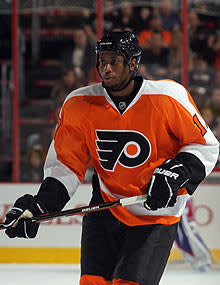NHL players need to share responsibility for change
No excuses. Not anymore. If you're a player in the National Hockey League and you don't know the dangers of painkillers, depression and concussions, if you don't know the new rules governing boarding and illegal checks to the head, if you don't know the intolerance for racism and homophobia, then you haven't been paying attention.
And you need to start now.
Amid all the good in the game – the thrilling action, the tight competition, the inspiring stories – so much bad has (over)shadowed hockey. The deaths of Derek Boogaard(notes), Rick Rypien(notes) and Wade Belak(notes). The concussion crisis, which still stars the NHL's best player, Pittsburgh Penguins captain Sidney Crosby(notes). Brutal hits. A homophobic slur allegedly hurled at an opponent by the Philadelphia Flyers’ Wayne Simmonds(notes).
One thing ties it all together. At least one thing should.
Awareness.
In this information age, we know more about these issues and dig into them deeper than ever before. The NHL and NHL Players' Association have gone farther than ever before in trying to address them. Have they been perfect? No. But they never will be, and the next and most important step will always reside with the players themselves. Individually and collectively, they have to look, listen and learn. For their own good, they have to make an active effort to change their behavior.
I understand that players are going to push themselves to the edge as they fight for contracts and victories. That's their job. I believe it's up to the league and union to determine where that edge is and communicate it clearly. When a player goes over the edge, the league and union need to help and punish as warranted. As times change and the standards change with them, players aren't going to break old habits overnight, let alone change the entire culture.
"Listen, first of all, it's extremely early in the season," said Mathieu Schneider(notes), special assistant to NHLPA executive director Don Fehr, speaking about the recent rash of hits and suspensions. "There's going to be an adjustment period, like with any rule changes."
But when problems arise in the game, we can't look only to the league and union and ask what they're going to do about it.
The league and union have a substance abuse and behavioral health program, but if players don't take advantage of it, it won't do any good. The league has instituted a new return-to-play protocol for concussions, but if players don't tell the truth, it won't do any good.
The league – with input from the union – has introduced new rules governing boarding and illegal checks to the head, stiffer suspensions for repeat offenders and video explanations, but if the players don't watch the videos, heed the warnings and adapt to the new rules, it won't do any good. Forget the wording of the new rules and the gray areas. The spirit of the new rules is crystal clear: You cannot even push an opponent into the boards dangerously. You cannot target an opponent's head from any direction. If you are reckless, you are responsible.
"The overall theme is trying to get guys to hit body on body, to make a real strong effort to stay away from guys' heads, and that's not going to change," Schneider said. "I think everybody's on board for that."
As for racism and homophobia, everybody better get on board for that, too. After someone threw a banana at Simmonds last week during an exhibition in London, Ont., there seemed to be progress. There was outrage all over the hockey world, while Simmonds was calm and classy.
Then Simmonds allegedly directed a homophobic slur at the New York Rangers’ Sean Avery(notes), who might be a foul-mouthed agitator himself but has stood up for gay rights. Simmonds claimed amnesia with reporters, then innocence with the league. He escaped punishment. Colin Campbell, the NHL's senior executive vice-president of hockey operations, said in a statement that league officials were "unable to substantiate with the necessary degree of certainty what was said and by whom," even though a video clip seems to clearly show what Simmonds said. Campbell said no on-ice official "heard any inappropriate slurs," even though that video clip shows an official right next to Simmonds.
Read my lips: Even if there wasn't audio evidence, the video alone should have been enough for Campbell to act. Let Simmonds appeal. Let the union grieve the case based on the process. Even if the league loses, everyone wins, because a larger point was made. Right now it just looks like no one ever learns.
Campbell's statement – as toothless as it was without any discipline behind it – was correct: "While we recognize that the emotion involved in certain on-ice confrontations may lead to the use of highly charged and sometimes offensive language and commentary, certain lines cannot be crossed." If there's a positive in all this, it's that we're seeing what's going on, we're asking questions and we're looking for solutions. We're starting to pay attention, including the players.
Schneider said those who have been suspended haven't been happy starring in those explanatory videos, with league disciplinarian Brendan Shanahan(notes) making examples of them. But he said the players generally have been happy about the transparency, and as the season goes on, we'll see how effective it is.
"It's something that we have to continue to talk to the guys about and make sure everyone feels that we're heading in the right direction," Schneider said. "It's going to be an ongoing evaluation from our side with the players. Obviously they're the most important ones, and their voices need to be heard."
Ultimately, when it comes to change, they have the last word.

 Yahoo Sports
Yahoo Sports 

